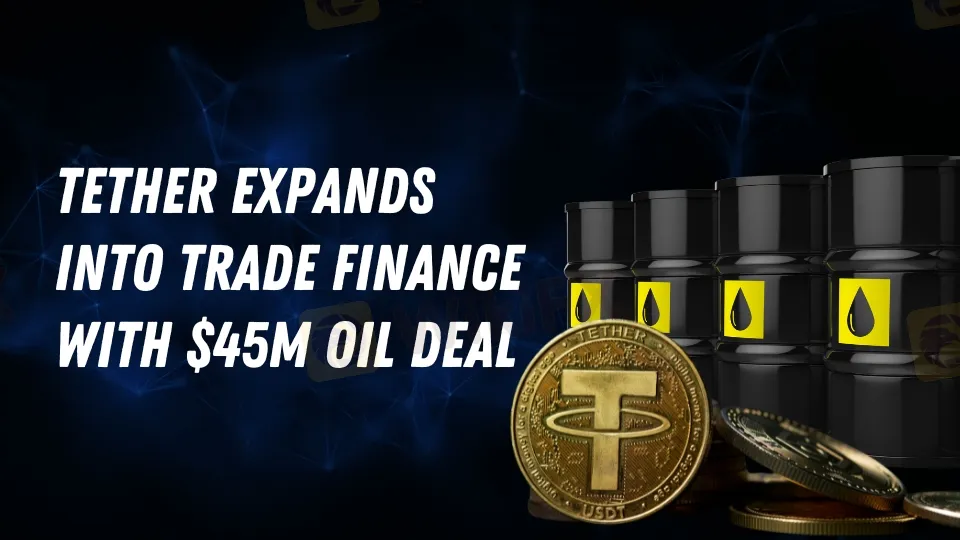简体中文
繁體中文
English
Pусский
日本語
ภาษาไทย
Tiếng Việt
Bahasa Indonesia
Español
हिन्दी
Filippiiniläinen
Français
Deutsch
Português
Türkçe
한국어
العربية
Tether Expands Into Trade Finance with $45M Oil Deal
abstrak:Tether enters the $10T trade finance market with a $45M crude oil deal, aiming to streamline cross-border transactions using USDT.

Tether, the world's biggest stablecoin issuer, has moved beyond digital money to the trade finance market. Tether recently financed a $45 million crude oil transaction between a big publicly listed oil company and a significant commodities dealer. This transaction, involving 670,000 barrels of Middle Eastern crude oil, marked Tether's debut in the $10 trillion trade finance business.
This move is part of Tether's larger diversification plan, which seeks to use the efficiency and speed of its USDT stablecoin to encourage cross-border transactions. Tether CEO Paolo Ardoino stressed the benefits of utilizing USDT over conventional payment methods, which are generally more expensive and have slower transaction rates.
Tether, in addition to trade financing, has a strong financial reserve structure to support its operations. Ardoino claims that Tether has $100 billion in US Treasury bonds, over 82,000 Bitcoin worth $5.5 billion, and 48 tons of gold. These assets support USDT's value and offer a strong safety net in the face of increased scrutiny of stablecoins in the cryptocurrency market.

Despite Tether's efforts to develop and diversify, the business remains under scrutiny by US regulatory organizations. According to a recent Wall Street Journal story, Tether is being investigated by the Manhattan US Attorney's Office and the US Treasury Department for potential anti-money laundering crimes and penalties. Ardoino, on the other hand, denied these allegations, claiming that Tether works within legal constraints and adheres to high standards in its financial reporting.
Tether has had an outstanding financial year. It posted a $2.5 billion profit in the third quarter of 2024, increasing the nine-month total to $7.7 billion. Tether's last quarterly attestation, undertaken by BDO Italy, affirmed its asset holdings of $125.5 billion versus $119.4 billion in liabilities, with a surplus reserve of more than $6 billion. Tether's asset mix consists mostly of cash and U.S. Treasury assets, as well as $5 billion in gold and $4.8 billion in bitcoin.
Tether also reported a huge growth in USDT circulation, which reached almost $120 billion in 2024, or a 30% increase. This increase in issuance reflects the stablecoin's increased demand and the wider acceptance of digital assets.
This increase in issuance reflects stablecoin demand and the wider acceptance of digital assets.
The company's move into trade financing demonstrates its desire to establish USDT as a viable instrument for global business. Tether, on the other hand, confronts regulatory hurdles in the United States, where sentiments have been rather conservative. Ardoino hopes that the 2024 U.S. Presidential elections will result in a more favorable regulatory environment for crypto enterprises, fostering development inside the nation rather than forcing them overseas.
Final Thoughts
Tether's entry into trade finance has the potential to transform the role of stablecoins in established sectors, especially for high-value cross-border transactions. However, regulatory constraints and continuous scrutiny in the United States provide issues that the corporation must manage with caution. Tether, with a strong financial reserve and aggressive expansion plans, is well-positioned to make a significant impact, assuming it can conform to growing global regulatory norms.

Disclaimer:
Ang mga pananaw sa artikulong ito ay kumakatawan lamang sa mga personal na pananaw ng may-akda at hindi bumubuo ng payo sa pamumuhunan para sa platform na ito. Ang platform na ito ay hindi ginagarantiyahan ang kawastuhan, pagkakumpleto at pagiging maagap na impormasyon ng artikulo, o mananagot din para sa anumang pagkawala na sanhi ng paggamit o pag-asa ng impormasyon ng artikulo.
Broker ng WikiFX
Exchange Rate


